|
Limitar tu búsqueda
[+–] Compilador o editor
[+–] Editorial
[+–] Fecha
[+–] Formato
[+–] Idioma
[+–] Tipo de documento
[+–] Tipo de recurso
[+–] Classification
|

|
|
El efecto de la percepción de la violencia en el capital social en México
El incremento en la violencia que presenta México con consecuencias en la ruptura del tejido social y en variables económicas clave nos llevan a analizar el efecto del cambio en la percepción de la violencia en el cambio en el capital social –como asociativismo- entre el 2006 y el 2011, periodo en el que se inició la política contra la violencia y el crimen organizado en México (2006-2012). Se...
|

|
|
|
|

|
|
Social security and inequality in Mexico: from polarization to universality
The article documents the failure of social security in Mexico as an instrument of social protection and evaluates possible reform strategies. It analyses the truncated coverage of these systems for the most vulnerable, the regressive incidence and horizontal inequities of public social security subsidies, and the consequences for old-age poverty and inequalities in basic health opportunities. It...
|

|
|
|
|

|
|
El capital social en el acceso al mercado laboral y la pobreza en México
El capital social, definido como el conjunto de redes sociales con las que cuenta una persona para obtener beneficios, es usado por la población como mecanismo para proveerse de recursos, amortiguar choques al consumo y para obtener información de las oportunidades de empleo disponibles. El objetivo de este trabajo es caracterizar el acceso al mercado laboral en México a través del uso de las...
|
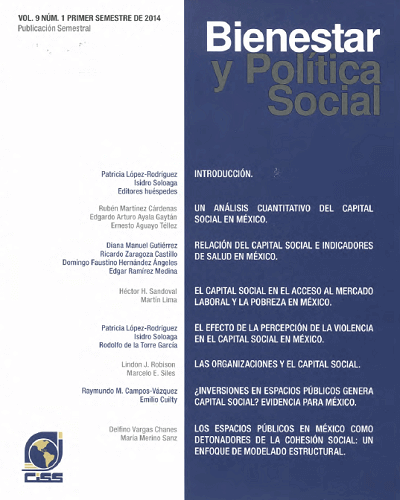
|
|
|
|

|
|
Relación del capital social e indicadores de salud en México
Este trabajo analiza la relación entre los tipos de capital social y el acceso a servicios de salud en México. Para ello, se valida la información de acceso a salud de la ENCASU 2006 y ENCAS 2011 con la información de la ENSANUT 2006 y 2012, encontrando consistencia en los indicadores. Se realiza un análisis estadístico de la distribución del capital social y de los indicadores de salud, por...
|

|
|
|
|

|
|
Un análisis cuantitativo del capital social en México
Se ha relacionado el capital social a la eficiencia en los mercados (Arrow, 1972), al refuerzo del contrato (Durlauf y Fafchamps, 2004) y en general al desarrollo y bienestar (Keefer y Knack 1997; Putnam 2000; Knack y Zak 2003). En el presente trabajo hemos investigado los determinantes del capital social empíricamente, centrándose en tres medidas comunes aproximadas de este: dos ligadas a la...
|

|
|
|
|

|
|
Introducción (sobre el tema de capital social que se aborda el presente número de la revista)
En las últimas décadas ha habido un creciente interés por identificar, estimar y relacionar el capital social con diversas variables del bienestar, donde la producción de beneficios o cierto rendimiento es clave. Esta actividad ha implicado la confluencia de diferentes disciplinas como la economía, la sociología, la antropología, la psicología, entre otras. A pesar de que no hay un consenso que...
|
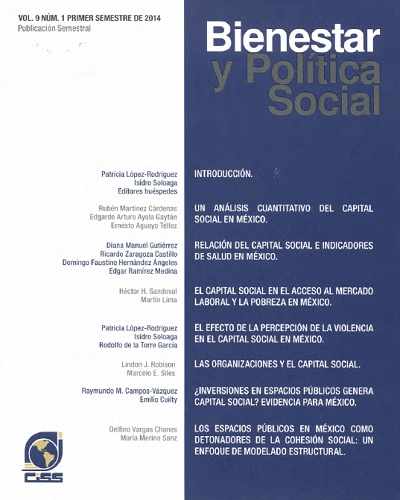
|
|
|
|

|
|
MiPYME en Costa Rica: crónica sobre su escasa integración en tiempos de una acelerada inserción internacional
El presente documento, está centrado en las Mipyme y en las políticas públicas para su fomento en la economía costarricense. El análisis, se hace a partir de un enfoque alternativo de clasificación de las actividades económicas, el cual permite precisar con mayor detalle las desigualdades entre las actividades tradicionales de amplia trayectoria en la economía, de aquellas actividades que han...
|
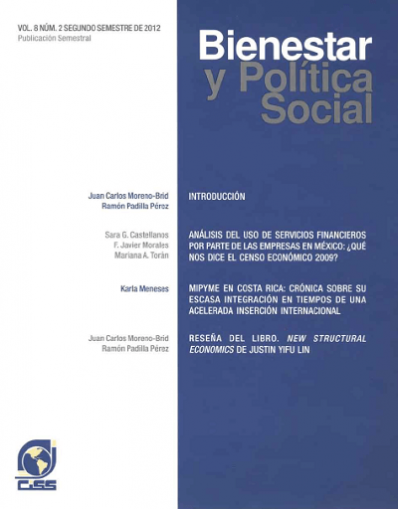
|
|
|
|

|
|
Análisis del uso de servicios financieros por parte de las empresas en México: ¿Qué nos dice el Censo Económico 2009?
Se presenta un análisis descriptivo de los resultados del Censo Económico 2009 acerca del uso de créditos y cuentas bancarias entre empresas. Para ello, se le solicitó al INEGI una serie de estadísticas sobre diversas características de las empresas que resultan relevantes en las decisiones de oferta de servicios bancarios. Esta información se solicitó agrupada según diversos segmentos por tamaño...
|

|
|
|
|

|
|
Introducción (sobre los temas que aborda el presente número de la revista)
Las micro y pequeñas empresas (MYPES) son actores centrales para el desarrollo productivo en América Latina por su contribución a la generación de empleo, su participación en el número total de empresas y, en menor medida, su aportación al producto interno bruto. No obstante, su producción está vinculada principalmente al mercado interno y se caracterizan por una creciente brecha de productividad...
|

|
|
|
|

|
|
Restrictions, problems and dilemmas of social provision in Latin America: facing challenges from aging and income inequality
This paper discusses the main restrictions, problems and dilemmas that social provision faces in Latin America in a context of demographic changes and low achievements in the economic performance, particularly in the labor market. It is proposed the need to adapt the general social provision matrix as function of priorities and restrictions set by financing access. Due to the limited labor...
|

|
|
|
|

|
|
Provisional and welfare inclusion in Brazil (1988-2005): scope and limits
This paper analyses the influence of new rights derived from the Social Security System in Brazil after the Federal Constitution (1988). At least, three different and independent forces determinate the arrangements in social security policies: 1) the new social rights created by constitutional rules in response to social pressure; 2) the decrease of employment and wages in salaried jobs imposed...
|
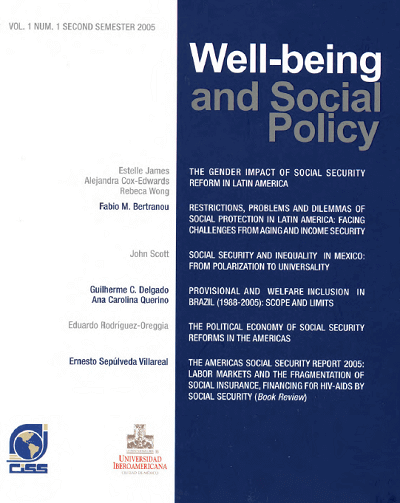
|
|
|
|

|
|
Empleabilidad y productividad entre trabajadores mayores: un marco de política y evidencia en Latinoamérica
Conforme los países latinoamericanos y del Caribe, enfrentan rápidas transiciones de envejecimiento, la contribución económica de los trabajadores de edad avanzada debería ser fortalecida. En este artículo se emplean datos domésticos de Brasil y México tales como la participación el sector y el tipo de empleo, para caracterizar el comportamiento del mercado laboral de los trabajadores de edad...
|

|
|
|
|

|
|
Introduction (about an international conference on "The effects of migration on sending countries")
The Inter-American Conference on Social Security (CISS) and Universidad Iberoamericana (UIA) co-hosted an international conference on “The Effects of Migration on Sending Countries” in February of 2006. The major objective of the conference was to examine a variety of channels through which migration affects the sending countries. Migrants change the dynamic of sending households; alter labor...
|
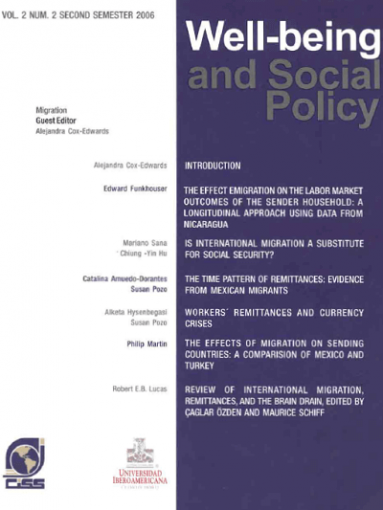
|
|
|
|

|
|
Inequality, quality of primary education and development in Latina America and the Caribbean
This paper draws on a political economy model to hypothesize that the quality of education is likely to be lowered by both economic and political inequalities. In particular, we utilize a panel data set across countries and over time to test the applicability of the hypothesis to quality of education indicators at the primary level. Among the four specific indicators of primary education assigned...
|
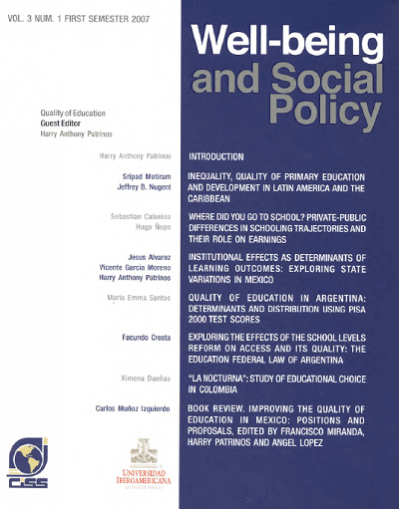
|
|
|
|

|
|
Introduction (about the international conference on "The quality of education in Latin America and the Caribbean")
The Inter-American Conference on Social Security (CISS) and Universidad Iberoamericana (UIA) co-hosted an international conference on "The Quality of Education in Latin America and the Caribbean" in February 2007. The main obj ective of the conference was to examine quality of education in the region, the determinants of learning, policy and program evaluation, and the impact of quality of...
|

|
|
|
|

|
|
The effects of migration on sending countries: a comparison of Mexico and Turkey
International migrants are persons who cross national borders and remain outside their countries of birth or citizenship for 12 months or more, regardless of the reason for being abroad or legal status while abroad. According to UN estimates, the number of international migrants was 191 million in 2005, and half were in the labor force of the destination country. International labor migration...
|

|
|
|
|

|
|
Workers' remittances and currency crises
We seek to further understand the factors that determine per emigrant remittances using data from 23 Latin American and Caribbean countries over the 1980-2003 period. We find that emigrants avoid remitting when the exchange rate is under pressure. This finding is consistent with the notion that remitters strive to reduce their exposure to exchange rate losses by taking into account the expected...
|
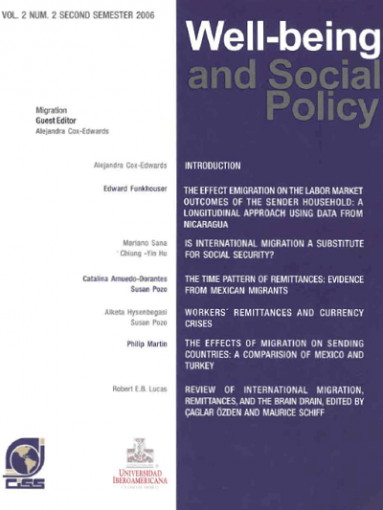
|
|
|
|

|
|
The time pattern of remittances: evidence from mexican migrants
We explore the time pattern of remittances using data on return migrants from the Mexican Migration Project. Some of these return migrants have settled in the U.S. and are returning to Mexico to visit family and friends, whereas others are temporary migrants returning home after a working spell in the U.S. We find that the dollar amount remitted first increases with time spent in the U.S. to...
|
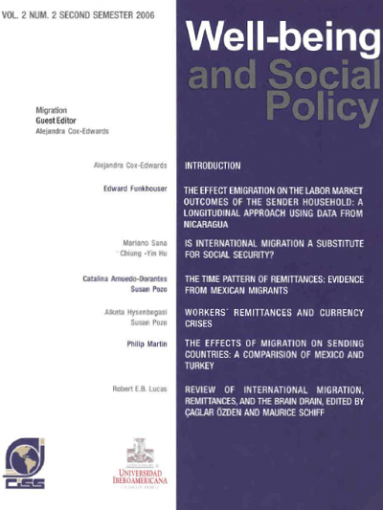
|
|
|
|

|
|
Is international migration a substitute for social security
The focus on short-term macroeconomic factors, including unemployment and wages, is insufficient to explain international migration. Institutional factors, bound to change only in the long run, can potentially have a large impact on migration flows. To illustrate this, we analyze Mexico-U.S. migration focusing on social security coverage, an important indicator of job formality. Using...
|
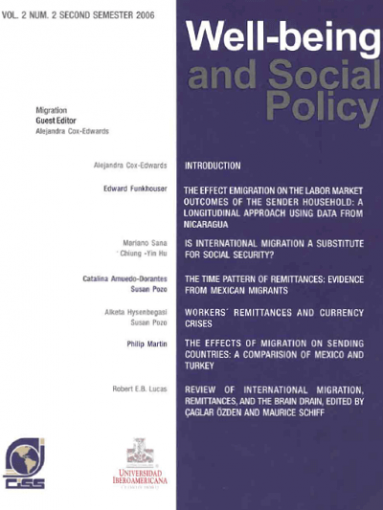
|
|
|
|

|
|
The effect of migration on the labor market outcomes of the sender household: a longitudinal approach using data from Nicaragua
In this paper, I use longitudinal data from the 1998 and 2001 Living Standard Measurement Surveys in Nicaragua to examine the impact of the emigration of household members on the household labor market integration and poverty. The main findings of the paper are that households from which an emigrant left had a reduction in members, a reduction in working members, a reduction in labor income than...
|
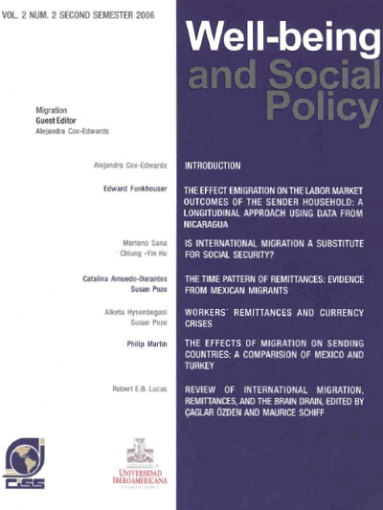
|
|
|
|
|